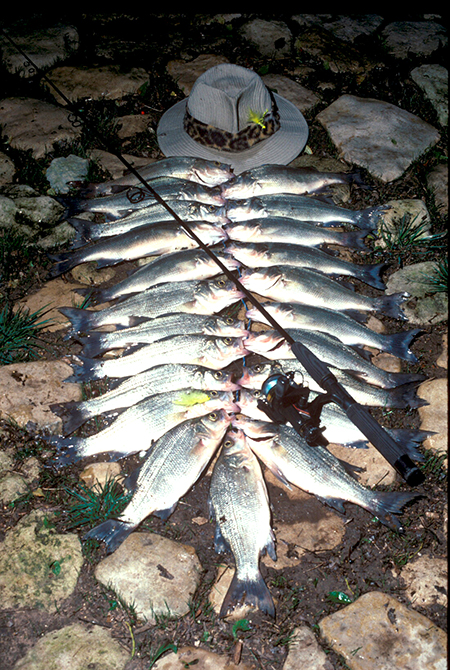
PICTURED IS ONE FEBRUARY’S late afternoon catch of white bass. Early mornings can be productive, too. During the peak of the spawn, the bite can last all day. Bank and wade fishing are productive. White bass are excellent table food if fileted, any red meat removed, and the filets are rolled in “Bisquick,” and fried. They’re about the only fish fried in the author’s house. (Photo by John Jefferson)
by John Jefferson
White Bass fishing and February and March go together like rice and gravy.
But growing up, I knew more about rice and gravy than I did about white bass fishing — or about white bass at all.
Growing up in lower East Texas, I had never heard of them. These frisky little fighting fish were native to the Red River area. They didn’t make it down south. My Beach Creek fishing world didn’t have many largemouth bass, and NO white bass. It took the rampant dam development on Texas rivers and major streams in the Fifties that created deep lakes to bring white bass to prominence.
They live most of their life in deep lakes, chasing shad in thrashing schools near the surface. When they’re not doing that, they congregate in deep holes. But then, like it’s said about “spring fever”– they follow the age old urge to mate. And that’s where February and March come into play.
Most years, many of the lakes’ white bass will swim up the streams feeding the lakes to spawn. If drought has restricted flow, they may spawn against a wind-swept shore.
It starts with the anxious males leading the charge. They’re usually a little smaller than the females, but are just as frisky when hooked.
Later – maybe as much as a month – the girls show up. When they’re ready to spawn, female white bass approach the surface of the flowing streams. The anxious males follow. Eggs are released and several males fertilize them as they sink to rocks or gravel below. They hatch in two or three days. Mature females can release up to 900,000 eggs!
Although February and March seem to be the optimum months for fruitful fishing during the spawn, I often get reports of whites being caught at Colorado Bend State Park on the Colorado River west of Lampasas on warm, sunny days in late January.
One of my best stringers of twenty-five, ten-inches or longer whites (the legal limits) came after sundown one chilly, early February evening.
Fishing the crystal-clear waters of Sandy Creek near Jonestown that afternoon, nothing was biting. No whites, yet. Sandy feeds Lake Travis. I had jumped out onto a large rock just offshore. We stayed until dark. As I began reeling in to leave, I felt a bump. I figured my small jig had struck a rock. But just in case, I cast again to the same place. This time, it really was a strike!
After stringing that white, I cast again. And again. And again — landing twenty-five bass in about thirty minutes! My stringer was so heavy that I had to swing it over to my compadre on the bank. Trying to jump with a heavy string of fish would put both the fish and me in the cold creek!
Spinning gear, light line, and small white or chartreuse jigs work well. Any small lure resembling shad will, too.
This bedlam occurs all over the eastern two-thirds of Texas. Get in on it!
JJ




